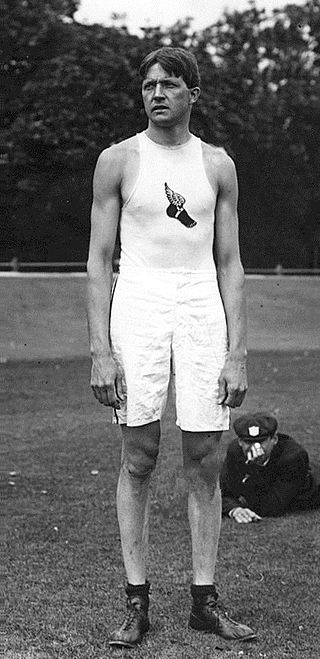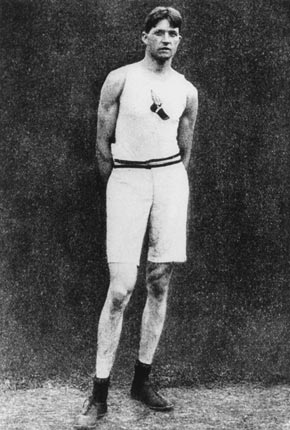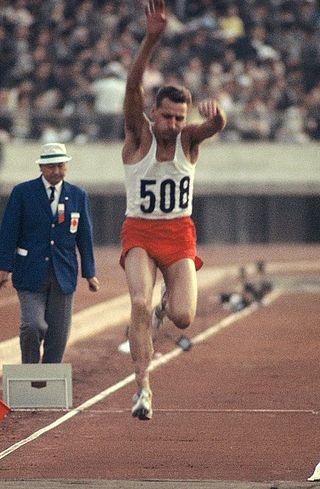
Raymond Clarence Ewry was an American track and field athlete who won eight gold medals at the Olympic Games and two gold medals at the Intercalated Games. This puts him among the most successful Olympians of all time.

The men's standing long jump was a track & field athletics event at the 1900 Summer Olympics in Paris. It was held on July 16, 1900. Four athletes from two nations competed in the standing long jump. The event was won by Ray Ewry of the United States, with his teammate Irving Baxter the runner-up; the two dominated all three of the standing jumps in 1900, finishing first and second in each. Ewry would take gold medals in all eight standing jump events from 1900 to 1908. The bronze medal was won by Émile Torchebœuf of France.

The men's standing triple jump was a track & field athletics event at the 1900 Summer Olympics in Paris, France. It was held on July 16, 1900. 10 athletes from four nations competed in the standing triple jump. The event was won by Ray Ewry of the United States, who took gold in all three of the standing jumps in 1900. His teammate Irving Baxter earned silver in all three 1900 standing jumps. The American sweep was completed with Robert Garrett taking bronze.

The men's triple jump was one of four men's jumping events on the Athletics at the 1964 Summer Olympics program in Tokyo. It was held on 16 October 1964. 36 athletes from 23 nations entered, with 2 not starting in the qualification round. The maximum number of athletes per nation had been set at 3 since the 1930 Olympic Congress. The event was won by Józef Szmidt of Poland, the third man to repeat as Olympic champion in the triple jump. Just as in 1960, the Soviet Union took silver and bronze behind Szmidt.

The men's standing high jump was one of six jumping events on the athletics at the 1908 Summer Olympics programme in London. The competition was held on July 23, 1908. 23 high jumpers from eleven nations competed. NOCs could enter up to 12 athletes. The event was won by Ray Ewry of the United States, his third consecutive victory in the event. Ewry won all eight standing jump events from 1900 to 1908 as well as both events at the 1906 Intercalated Games. Konstantinos Tsiklitiras of Greece took silver, tying with American John Biller. Tsiklitiras was the first non-American to medal in the event; the United States had swept the medals in both 1900 and 1904.

The men's standing long jump was one of six jumping events on the athletics at the 1908 Summer Olympics programme in London. The competition was held on Monday, July 20, 1908. Twenty-five long jumpers from eleven nations competed. NOCs could enter up to 12 athletes. The event was won by Ray Ewry of the United States, his third consecutive victory in the event. Ewry won all eight standing jump events from 1900 to 1908 as well as both events at the 1906 Intercalated Games. Konstantinos Tsiklitiras of Greece took silver. American Martin Sheridan earned bronze.

Greece competed at the 1912 Summer Olympics in Stockholm, Sweden. 22 competitors, all men, took part in 25 events in five sports. Greek athletes have competed in all Summer Olympic Games.

The men's standing long jump was a track and field athletics event held as part of the athletics at the 1904 Summer Olympics programme. It was the second time the event was held. The competition was held on Monday, August 29, 1904. Four athletes, all from the United States, competed. Ray Ewry continued his dominance of the standing jumps at the Olympics, successfully defending his championships in this one as well as the other two. He also set a new world record. Charles King took silver, with John Biller receiving bronze.

The men's standing triple jump was a track and field athletics event held as part of the Athletics at the 1904 Summer Olympics programme. It was the second time the event was held. It was held on September 3, 1904. Four athletes, all from the United States, competed. Ray Ewry continued his dominance of the standing jumps at the Olympics, successfully defending his championships in this one as well as the other two. Charles King took silver, with Joseph Stadler earning bronze. With only Americans competing, the second consecutive sweep was assured; with the event no longer held after these Games, no non-American athlete ever won a medal in the standing triple jump.

The men's standing high jump was a track and field athletics event held as part of the Athletics at the 1904 Summer Olympics programme. It was the second time the event was held. It was held on August 31, 1904. 5 athletes from 2 nations competed. Ray Ewry continued his dominance of the standing jumps at the Olympics, successfully defending his championships in this one as well as the other two. Joseph Stadler took silver, with Lawson Robertson earning bronze to complete the American sweep.

The men's long jump was a track and field athletics event held as part of the athletics at the 1912 Summer Olympics programme. The competition was held on Friday, July 12, 1912. Thirty long jumpers from 13 nations competed. NOCs could enter up to 12 athletes. The event was won by Albert Gutterson of the United States, the nation's fifth gold medal in the event in five Games. Calvin Bricker of Canada became the second man to win a second medal in the long jump, adding a silver to his 1908 bronze. Sweden won its first long jump medal with Georg Åberg's bronze.

The men's triple jump, also known as the hop, step, and jump, was a track and field athletics event held as part of the Athletics at the 1912 Summer Olympics programme. The competition was held on Monday, July 15, 1912. Twenty athletes from eight nations competed. NOCs could enter up to 12 athletes. The event was won by Gustaf Lindblom of Sweden, the nation's first medal in the men's triple jump. Georg Åberg and Erik Almlöf also medaled for Sweden, completing a sweep—previously accomplished twice by the United States in 1900 and 1904.

The men's standing high jump was a track and field athletics event held as part of the athletics at the 1912 Summer Olympics programme. It was the fourth and final appearance of the event. The competition was held on Saturday, July 13, 1912.

The men's discus throw was a track and field athletics event held as part of the athletics at the 1912 Summer Olympics programme. The competition was held on Friday, July 12, 1912. Forty-one discus throwers from 15 nation competed. NOCs could enter up to 12 athletes. The event was won by Armas Taipale of Finland, the nation's first medal in the men's discus throw. Richard Byrd took silver and James Duncan took bronze to continue the United States' podium streak at five consecutive Games.

The men's triple jump event was part of the track and field athletics programme at the 1920 Summer Olympics. The competition was held from Thursday, August 19, 1920, to Saturday, August 21, 1920. Twenty-one triple jumpers from eight nations competed. No nation had more than four jumpers, suggesting the limit had been reduced from the 12 maximum in force in 1908 and 1912. The event was won by Vilho Tuulos of Finland, the nation's first medal in the triple jump. Sweden, which had swept the medals in 1912, took the next three places. Erik Almlöf became the third man to win two medals in the event, repeating his bronze performance from 1912.

The men's long jump was one of four men's jumping events on the Athletics at the 1968 Summer Olympics program in Mexico City. The long jump took place on 18 October 1968. Thirty-five athletes from 22 nations competed. The maximum number of athletes per nation had been set at three since the 1930 Olympic Congress.

The men's high jump event at the 2000 Summer Olympics as part of the athletics program was held at the Olympic Stadium on Friday, 22 September and Sunday, 24 September. Thirty-five athletes from 24 nations competed. The maximum number of athletes per nation had been set at 3 since the 1930 Olympic Congress. The high jump has been ever present since the beginning of the modern Olympic Games in 1896. The event was won by Sergey Klyugin of Russia, the nation's first medal and victory in the men's high jump in the nation's first appearance after the breakup of the Soviet Union. Javier Sotomayor of Cuba was the eighth man to win a second medal in the event ; he joined Valeriy Brumel and Jacek Wszoła as the most successful Olympic high jumpers in history with a gold and a silver—despite missing the 1984 and 1988 Games due to boycott and being hampered by injury in 1996. Abderrahmane Hammad's bronze was Algeria's first medal in the men's high jump.

The high jump at the Summer Olympics is grouped among the four track and field jumping events held at the multi-sport event. The men's high jump has been present on the Olympic athletics programme since the first Summer Olympics in 1896. The women's high jump was one of five events to feature on the first women's athletics programme in 1928, and it was the only jumping event available to women until 1948, when the long jump was permitted.

The long jump at the Summer Olympics, is grouped among the four track and field jumping events held at the multi-sport event. The men's long jump has been present on the Olympic athletics programme since the first Summer Olympics in 1896. The women's long jump was introduced over fifty years later in 1948, and was the second Olympic jumping event for women after the high jump, which was added in 1928.

The triple jump at the Summer Olympics is grouped among the four track and field jumping events held at the multi-sport event. The men's triple jump has been present on the Olympic athletics programme since the first Summer Olympics in 1896. The women's triple jump is one of the more recent additions to the programme, having been first contested in 1996. It became the third Olympic jumping event for women after the high jump and long jump.
























